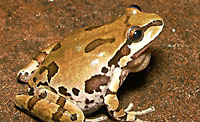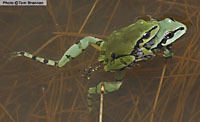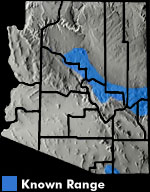Online Field Guide to The Reptiles and Amphibians of Arizona


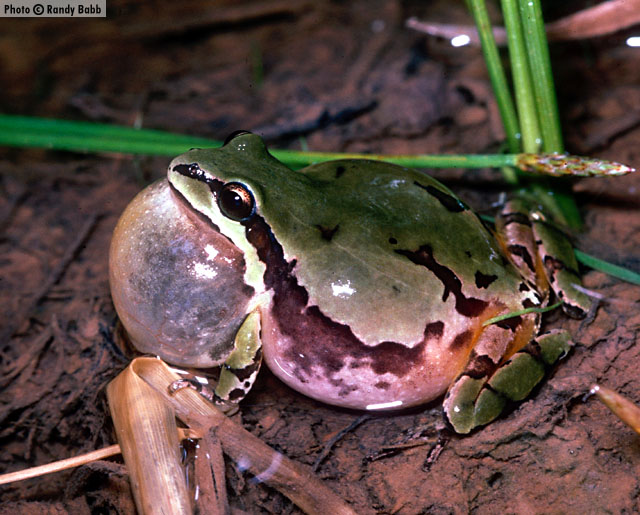
Male calling. Cochise County, AZ
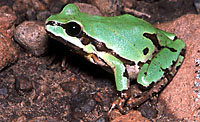 Navajo Co., AZ |
||
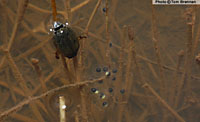 Egg mass. Coconino Co., AZ |
| ARIZONA TREEFROG Hyla wrightorum | |
|
DESCRIPTION: The Arizona Treefrog is a relatively small (to 2.25 inches) green or coppery brown frog with a dark eyestripe that extends past the shoulder onto the side of the body, and sometimes to the groin area. This dark stripe may break into spots or dashes past the shoulder. The eyestripe on the similar Pacific treefrog does not extend past the shoulder. Some individuals exhibit dark spots on the head and upper back, and bars or spots on the lower back. The throat of the male is dusky green or tan, and males average a slightly smaller size than females. Larger tadpoles are golden-brown above and below with tails mottled black. They grow to about 1.5 inches. DISTRIBUTION: Occurs primarily above the Mogollon Rim from the vicinity of Williams east and south into New Mexico. Isolated populations exist in the Sierra Anchas, but also in the Huachuca Mountains and adjacent Canelo Hills in southeastern Arizona. HABITAT: The Arizona Treefrog is a species of montane streams, wet meadows, ciénegas, roadside ditches, and livestock tanks in oak, pine-oak, pondersosa pine, Douglas fir, and other forest types, mostly above 5,000 feet. The breed most commonly in temporary waters, which support relatively few aquatic predators. BEHAVIOR: Habits outside the breeding season are poorly known; however, non-breeding frogs can climb high into the trees or may be found on the ground in wet meadows or other damp places. A wintering frog was collected from a debris pile in January near Christopher Creek. REPRODUCTION AND CALLS: Arizona Treefrogs breed at the beginning of the summer monsoon season. Breeding choruses typically last for only 2-3 days, after which most frogs leave the breeding habitats. However, occasional calling frogs can be heard through the summer. At the beginning of the monsoons, these frogs have been heard calling from the treetops. The call is a metallic clink, repeated 1-3 times per second. Eggs are laid in small clusters attached to vegetation. Tadpoles metamorphose in about 6-11 weeks. DIET: In Arizona, Arizona Treefrogs have been found to feed on beetles, spiders, earthworms, flies, and bark beetles. They likely feed on a variety of other small invertebrates, as well. REMARKS: Populations in the Huachuca Mountains and Canelo Hills differ in morphology, calls, and mitochondrial DNA from both the Mogollon Rim frogs and H. wrightorum from the Sierra Madre Occidental of Sonora, and may represent a different subspecies or species. These disjunct populations are small and threatened by catastrophic fire, drought, and introduced predators. By Jim Rorabaugh
Gergus, E.W.A., T.W. Reeder, and B.K. Sullivan. 2004. Geographic variation in Hyla wrightorum:advertisement calls, allozymes, mtDNA, and morphology. Copeia 2004(4):758-769. Gergus, E.W.A., J.E. Wallace, and B.K. Sullivan. 2005. Hyla wrightorum: (eximia) Taylor, 1938(a) Arizona Treefrog. Pages 461-463 in M.J. Lannoo (ed), Amphibian Declines: The Conservation Status of United States Species. University of California Press, Berkeley, CA. Sredl, M.J., and J.P. Collins. 1992. The interaction of predation, competition, and habitat complexity in structuring an amphibian community. Copeia 1992(3):607-614. Sullivan, B.K. 1986. Advertisement call variation in the Arizona treefrog, Hyla wrightorum Taylor, 1938. Great Basin Naturalist 46(2):378-381. Zweifel, R.G. 1961. Larval development of the tree frogs Hyla arenicolor and Hyla wrightorum. American Museum Novitates 2056:1-19. |
|
Visit Partners in Amphibian and Reptile Conservation:


HOME
Copyright © 2023, Arizona Game and Fish Department. All rights reserved.
If you make use of the textual contents of this site in reports, publications, etc. please cite and credit the author(s) and photographer(s). All photos on this website are copyrighted. However, those found in the species account section may be used for any noncommercial scientific, educational, or conservation purposes provided that photographs are not altered and continue to bear the copyright symbol and name of the photographer. Please contact the photographer regarding commercial use of copyrighted photographs.










